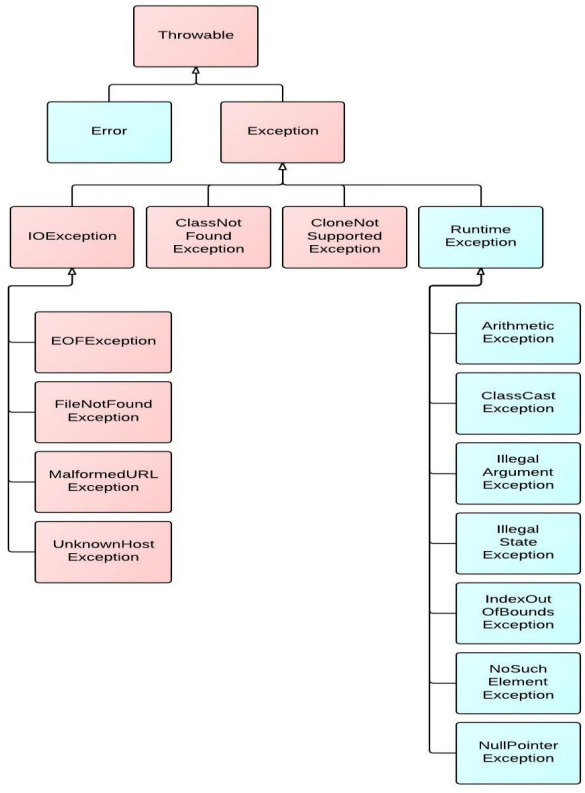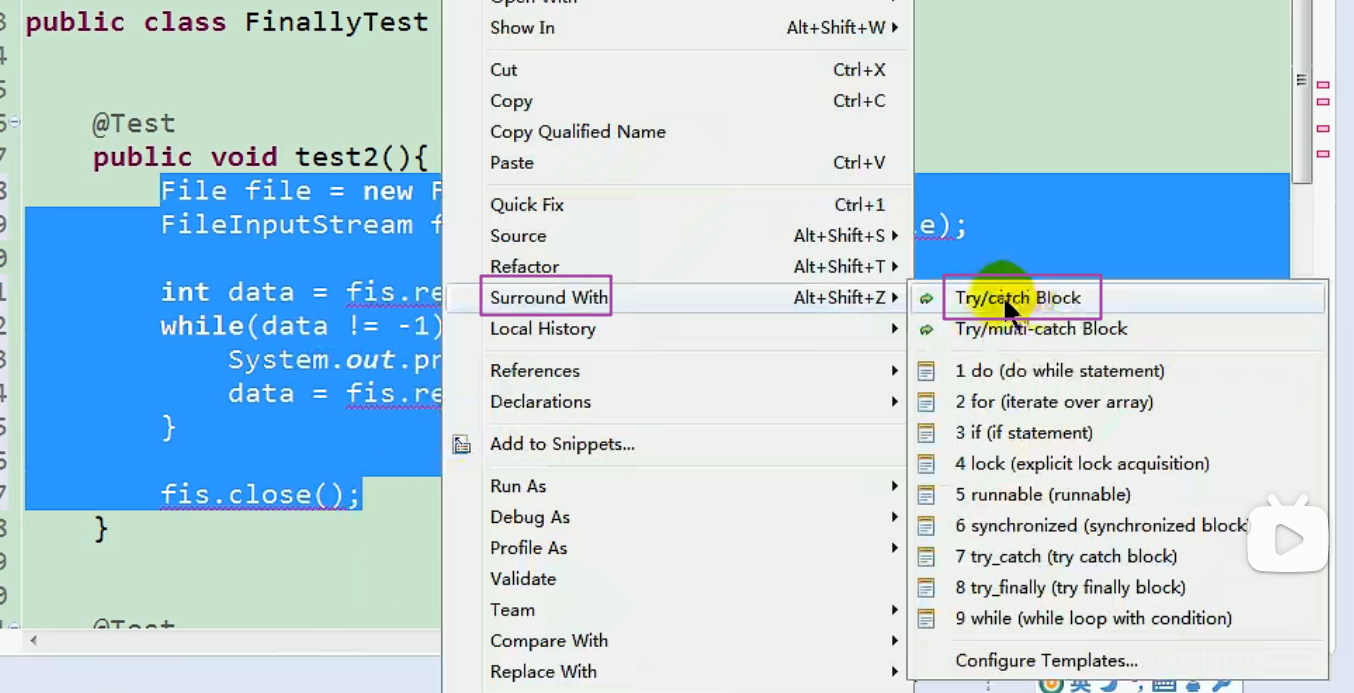异常概述与异常体系结构
异常概述
在使用计算机语言进行项目开发的过程中,即使程序员把代码写得尽善尽美, 在系统的运行过程中仍然会遇到一些问题,因为很多问题不是靠代码能够避 免的,比如:客户输入数据的格式,读取文件是否存在,网络是否始终保持 通畅等等。
异常:在Java语言中,将程序执行中发生的不正常情况称为“异常” 。 (开发过程中的语法错误和逻辑错误不是异常)
Java程序在执行过程中所发生的异常事件可分为两类:
①Error(错误):Java虚拟机无法解决的严重问题。如:JVM系统内部错误、资源耗尽等严重情况。比如:StackOverflowError和OOM。一般不编写针对性的代码进行处理。
public class ErrorTest{
public static void main(String[] args){
//1.栈溢出:java.lang.StackOverflowError
main(args);
//2.堆溢出:java.lang.OutOfMemoryError
Integer[] arr=new Integer[1024*1024*1024];
}
}
②Exception(狭义的异常):其它因编程错误或偶然的外在因素导致的一般性问题,可以使用针对性的代码进行处理。例如: 空指针访问,试图读取不存在的文件,网络连接中断,数组角标越界
对于这些错误,一般有两种解决方法:一是遇到错误就终止程序的运行。另一种方法是由程序员在编写程序时,就考虑到错误的检测、错误消息的提示,以及错误的处理。
捕获错误最理想的是在编译期间,但有的错误只有在运行时才会发生。 比如:除数为0,数组下标越界等 ->分类:编译时异常和运行时异常
异常体系结构
编译时异常:执行javac.exe命令时,可能出现的异常
运行时异常:执行java.exe命令时,可能出现的异常
红色:受检(checked)异常
蓝色:非受检(unchecked)异常

1.运行时异常:是指编译器不要求强制处置的异常。一般是指编程时的逻辑错误,是程序员应该积极避免其出现的异常。java.lang.RuntimeException类及它的子类都是运行时异常。
对于这类异常,可以不作处理,因为这类异常很普遍,若全处理可能会对 程序的可读性和运行效率产生影响。
2.编译时异常:是指编译器要求必须处置的异常。即程序在运行时由于外界因素造成的一般性异常。编译器要求Java程序必须捕获或声明所有编译时异常。
对于这类异常,如果程序不处理,可能会带来意想不到的结果。
java.lang.Throwable
|-----java.lang.Error:一般不便携针对性的代码进行处理
|-----java.lang.Exception:可以进行异常处理
|-----编译时异常(checked)
|-----IOException
|-----FileNotFoundException
|-----CLassNotFoundException
|-----运行时异常(unchecked)
|-----NullPointerException
|-----ArrayIndexOutOfBoundsException
|-----ClassCastException
|-----NumberFormatException
|-----InputMismatchException
|-----ArithmeticException
常见异常
运行时异常:
NullPointerException
public class NullRef {
int i = 1;
public static void main(String[] args) {
NullRef t = new NullRef();
t = null;
System.out.println(t.i);
}
}
ArrayIndexOutOfBoundsException
public class EceptionTest{
@Test
public void test2(){
int[] arr=new int[10];
System.out.println(arr[10]);
}
}
StringIndexOutOfBoundsException
public class EceptionTest{
@Test
public void test2(){
String str="abc";
System.out.println(str.charAt(3));
}
}
ClassCastException
public class EceptionTest{
@Test
public void test3(){
Object obj=new Date();
String str=(String)obj;
}
}
NumberFormatException
public class EceptionTest{
@Test
public void test4(){
String str="123";
str="abc";
int num=Integer.parseInt(str);
}
}
InputMismatchException
public class EceptionTest{
@Test
public void test5(){
Scanner scanner=new Scanner(System.in);
int score=scanner.nextInt();
System.out.println(score);
}
}
ArithmeticException
public class EceptionTest{
@Test
public void test6(){
int a=10;
int b=0;
System.out.println(a/b);
}
}
编译时异常FileNotFoundException,IOException e
public class EceptionTest{
@Test
public void test7(){
File file=new File("hello.txt");
fis=new FileInputStream(file);
int data=fis.read();
while(data!=-1){
System.out.print((char)data);
data=fis.read();
}
fis.close();
}
}
异常处理机制一: try-catch-finally
一、异常的处理:抓抛模型
过程一:“抛”:程序在正常执行的过程中,一旦出现异常,就会在异常代码处生成一个对应异常类的对象。并将此对象抛出。一旦抛出对象后,其后的代码就不再执行。
关于异常对象的产生:①系统自动生成的异常对象,②手动的生成一个异常对象,并抛出(throw)
过程二:“抓”:可以理解为异常的处理方式:①try-catch-finnally,②throws
二、try-catch-finally的使用
格式:
try{
//课程出现异常的代码
}catch(异常类型1 变量名1){
//处理异常的方式1
}catch(异常类型2 变量名2){
//处理异常的方式2
}catch(异常类型3 变量名3){
//处理异常的方式3
}finally{
//一定会执行的代码
}
两种常用的报错方式:
try{
}catch(Exception e){
System.out.println(e.getMessage());
e.printStackTrace();
}
体会1:使用try-catch-finally处理编译时异常,使得程序在编译时就不再报错,但是运行时仍可能报错。相当于我们使用try-catch-finally将一个编译时可能出现的异常,延迟到运行时出现。
体会2:开发中,由于运行时异常比较常见,所以我们通常就不针对运行时异常编写try-catch-finally,针对编译时异常,我们一定要考虑异常处理。
RuntimeException类或是它的子类,即使没有使用try和catch捕获,Java自己也能捕获,并且编译通过。非运行时异常,则必须捕获,否则编译错误。也就是说,我们必须处理编译时异常,将异常进行捕捉,转化为运行时异常。
说明:
- finally是可选的
- finally中声明的是一定会被执行的代码。即使“catch中又出现异常了,try中又return语句,catch中又return”等情况。即,finally=="等等!我先执行"
- 一旦try中的异常对象匹配到某一个catch时,就进入catch中进行异常的处理。一旦处理完成,就跳出当前的try-catch结构(在没有写finally的情况),继续执行其后的代码
- catch中的异常类型如果没有子父类关系,则声明无论先后;否则要求子类一定声明在父类上面,不然会报错
- 常用的异常对象处理的方式:①String getMessage(),②printStackTrace()
- 在try结构中声明的变量,出了try结构以后,就不能再被调用
- try-catch-finally结构可以嵌套
可以用选中代码快->右键->Surround With->Try/catch Block,自动生成。

finally的再说明:
- finally是可选的
- finally中声明的是一定会被执行的代码
- 像数据库连接、输入输出流、网络编程Socket等资源,JVM是不能自动回收的,我们需要自己手动的进行资源的释放。此时的资源释放,就需要声明在finally中
public void test2(){
FileInputStream fis=null;
try{
File file=new File("hello.txt");
fis=new FileInputStream(file);
int data=fis.read();
while(data!=-1){
System.out.print((char)data);
data=fis.read();
}
}catch(FileNotFoundException e){
e.printStackTrace();
}catch(IOException e){
e.printStackTrace();
}finally{
try{
if(fis!=null)
fis.close();
}catch(IOException e){
e.printStackTrace();
}
}
}
hello.txt在当前的工程下。在工程下创建文件(先别写中文,因为字节流读不了字符)
异常处理机制二: throws
- “throws + 异常类型“写在方法的声明处。指明此方法执行时,可能会抛出的异常类型。
一旦当方法被执行时,出现异常,仍会在异常代码处生成一个异常类的对象,此对象满足throws后异常类型时,就会被抛出。异常代码后续的代码,就不再执行。 - 对比两种处理方式:try-catch-finally:真正的把异常处理掉了。throws的方式只是将异常抛给了方法的调用者,并没有真正的将异常处理掉。
ps.子父类抛出的异常大小关系:子类重写的方法抛出的异常类型不大于父类 - 开发中如何选择使用try-catch-finally和throws?
3.1 如果父类中被重写的方法没有throws方式处理异常,则子类重写的方法也不能使用throws,意味着如果子类重写的方法中有异常,必须使用try-catch-finally方式处理
3.2 执行的方法a中,先后调用了另外的几个方法,这几个方法是递进关系执行的。我们建议这几个方法使用throws的方式进行处理。而执行的方法a可以考虑使用try-catch-finally方式进行处理
手动抛出异常
Java异常类对象,除在程序执行过程中出现异常时由系统自动生成并抛出,也可根据需要使用人工创建并抛出。(throw)
throw和throws区别:
throw表示抛出一个异常类的对象,生成异常对象的过程。声明在方法体内。
throws属于异常处理的一种方式,声明在方法的声明处。
public class StudentTest{
public static void main(String[] args){
try{
Student s=new Student();
s.regist(-1001);
System.out.println(s);
}catch(Exception e){
System.out.prinln(e.getMessage());
}
}
}
class Student{
private int id;
public void regist(int id) throws Exception{
if(id>0){
this.id=id;
}else{
throw new Exception("您输入的数据非法");
}
}
}

用户自定义异常类
如何自定义异常类?
- 继承于现有的异常结构:RunTimeExcption、Exception
- 提供全局常量:serialVersionUID
- 提供重载的构造器
public class MyException extends RuntimeException{
static final long serialVersionUID = -9271957429329742L;
public MyException(){
}
public MyException(String message){
super(message);
}
}
class Student{
private int id;
public void regist(int id) throws Exception{
if(id>0){
this.id=id;
}else{
throw new MyException("您输入的数据非法");//抛出自定义的异常类型
}
}
}
练习:
public class EcmDef{
public sataic void main(String[] args){
try{
int i=Integer.parseInt(args[0]);
int j=Integer.parseInt(args[1]);
int result=ecm(i,j);
System.out.prinln(result);
}catch(NumberFormatException e){
System.out.prinln("数据类型不一致");
}catch(ArrayIndexOutOfBoundsException e){
System.out.prinln("缺少命令行参数");
}catch(ArithmeticException e){
System.out.prinln("除0");
}catch(EcDef e){
System.out.prinln(e.getMessage());
}
}
public static int ecm(int i,int j) throws EcDef{
if(i<0||j<0){
throw new EcDef("分子或分母为负数了");
}
return(i/j);
}
}
//自定义异常类
public class EcDef extends Exception{
static final long serialVersionUID = -32285492089542L;
public EcDef(){
}
public EcDef(String msg){
super(msg);
}
}
面试题总结:
类似型:
- final、finally、finalize
- throw、throws
- Collection、Collections
- String、StringBuffer、StringBuilder
- ArrayList、LinkedList
- HashMap、LinkedHashMap
- 重写、重载
结构不相似的:
- 抽象类、接口
- ==、equals()
- sleep()、wait()



Comments NOTHING